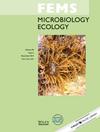瞬时缺氧驱动人类分解过程中的土壤微生物群落动力学和生物地球化学
IF 3.2
3区 生物学
Q2 MICROBIOLOGY
引用次数: 0
摘要
陆地生态系统中的人类分解是一个动态过程,会产生局部的土壤微生物活动热点。对分解者微生物群落的长期(超过几个月)影响还没有很好的描述,通常也没有将微生物群落与生物地球化学联系起来,这限制了我们对分解者群落及其功能的了解。我们分别在春季和冬季进行了为期一年的人类分解试验,将细菌和真菌群落结构和丰度与土壤物理化学和生物地球化学结合起来,以确定微生物群落变化的关键驱动因素。在这两项试验中,都出现了土壤酸化、微生物呼吸作用增强和土壤氧气浓度降低的情况。土壤氧气浓度的变化是微生物演替和氮转化模式的主要驱动因素,而真菌群落的多样性和丰度则与土壤 pH 值有关。在土壤氧气减少期间,兼性厌氧类群(真菌和酵母菌)的相对丰度增加。与冬季相比,春季试验期间分解反应的幅度和时间都有所扩大,即使对热输入(累积度日)进行校正也是如此。此外,土壤化学参数、微生物群落结构和真菌基因丰度在一年后仍会发生变化,这表明除了最初的分解产物脉冲外,土壤生态系统还会受到更长期的影响。本文章由计算机程序翻译,如有差异,请以英文原文为准。
Transient hypoxia drives soil microbial community dynamics and biogeochemistry during human decomposition
Human decomposition in terrestrial ecosystems is a dynamic process creating localized hot spots of soil microbial activity. Longer-term (beyond a few months) impacts on decomposer microbial communities are poorly characterized and do not typically connect microbial communities to biogeochemistry, limiting our understanding of decomposer communities and their functions. We performed separate year-long human decomposition trials, one starting in spring, another in winter, integrating bacterial and fungal community structure and abundances with soil physicochemistry and biogeochemistry to identify key drivers of microbial community change. In both trials soil acidification, elevated microbial respiration, and reduced soil oxygen concentrations occurred. Changes in soil oxygen concentrations were the primary driver of microbial succession and nitrogen transformation patterns, while fungal community diversity and abundance was related to soil pH. Relative abundance of facultative anaerobic taxa (Firmicutes and Saccharomycetes) increased during the period of reduced soil oxygen. The magnitude and timing of the decomposition responses was amplified during the spring trial relative to the winter, even when corrected for thermal inputs (accumulated degree days). Further, soil chemical parameters, microbial community structure, and fungal gene abundances remained altered at the end of one year, suggesting longer-term impacts on soil ecosystems beyond the initial pulse of decomposition products.
求助全文
通过发布文献求助,成功后即可免费获取论文全文。
去求助
来源期刊

FEMS microbiology ecology
生物-微生物学
CiteScore
7.50
自引率
2.40%
发文量
132
审稿时长
3 months
期刊介绍:
FEMS Microbiology Ecology aims to ensure efficient publication of high-quality papers that are original and provide a significant contribution to the understanding of microbial ecology. The journal contains Research Articles and MiniReviews on fundamental aspects of the ecology of microorganisms in natural soil, aquatic and atmospheric habitats, including extreme environments, and in artificial or managed environments. Research papers on pure cultures and in the areas of plant pathology and medical, food or veterinary microbiology will be published where they provide valuable generic information on microbial ecology. Papers can deal with culturable and non-culturable forms of any type of microorganism: bacteria, archaea, filamentous fungi, yeasts, protozoa, cyanobacteria, algae or viruses. In addition, the journal will publish Perspectives, Current Opinion and Controversy Articles, Commentaries and Letters to the Editor on topical issues in microbial ecology.
- Application of ecological theory to microbial ecology
- Interactions and signalling between microorganisms and with plants and animals
- Interactions between microorganisms and their physicochemical enviornment
- Microbial aspects of biogeochemical cycles and processes
- Microbial community ecology
- Phylogenetic and functional diversity of microbial communities
- Evolutionary biology of microorganisms
 求助内容:
求助内容: 应助结果提醒方式:
应助结果提醒方式:


